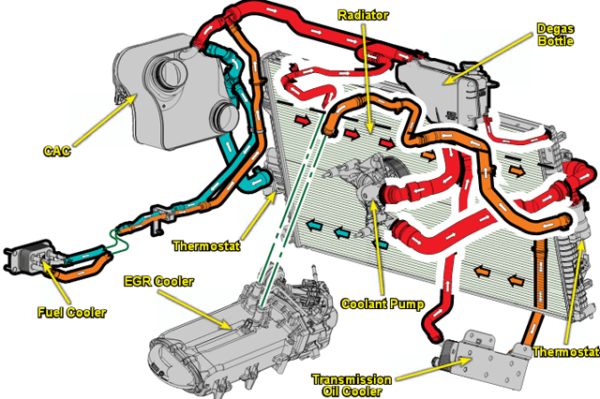
Helping Hand - Transmission Cooler R&D, Part 1 - Stock Review and Design
Many believe that the key to a great truck is a powerful engine when, in reality, the transmission can make or break a truck. Your 2011+ Ford F-Series equipped with the 6.7L Powerstroke was delivered with enough torque to spin the Earth off its axis. Still, without a sturdy transmission distributing that power, you're left with gear confetti in a transmission fluid stew. In short, maintaining proper temperatures in your Powerstroke is vital to keep it towing, pulling, and hauling to its full potential. It's about time the 6.7L was due for a cooling upgrade.
Before we can dive into the improvements, we need to understand the OEM system fully. In 2011, Ford upped the ante in the heavy-duty truck segment with the 6.7L Powerstroke, complete with all the technology to earn the Super Duty moniker, specifically the addition of an entire secondary cooling system. This system's focus is dissipating heat from the air-to-water intercooler and channels coolant through several of the vehicle's other systems, including the EGR, fuel, and, of course, transmission cooler.

The stock transmission cooler operates just like any other liquid-to-liquid cooler. Both fluids enter the cooler and flow through in alternating rows. From there, the laws of physics take over, and heat transfers from the hotter liquid to the colder liquid. The coolant then cycles back into the secondary cooling system, and the secondary radiator dissipates the heat. On paper, the system is ideal since the cooler isn't reliant on wind or the truck to be moving to maintain transmission temperatures. However, with every system, there are limitations. Prolonged heavy load or sustained operation in hotter climates can overload the system, potentially causing damage to the Powerstroke's transmission.

We plan to give the factory cooler an assist with an additional liquid-to-air cooler mounted under the grill. We elected to add a cooler to the stock system rather than a full replacement because removing the factory cooler from the equation could prove detrimental. This cooler's objective is to maintain the proper ATF temperature instead of lowering it as much as possible. Like most lubricants, automatic transmission fluid works best at a specified operating temperature, so overheating and overcooling would prove harmful. Keeping the stock cooler in the system allows the coolant from the secondary cooling system to cool and heat the transmission fluid and maintain proper levels.

Tying the additional cooler into the system is easier said than done. However, our engineer, Dan, is up to the task. Designing the cooler is the easy part, but now it needs to be secured into place. There is plenty of open real estate on the front of both the '11-'16 and '17+ models, but the cosmetic updates mean that bracketry will differ between the kits.

With the mounting set, Dan focused on integrating the cooler into the secondary cooling system. The plan is to tie our cooler into the system before the stock unit. However, the refresh for the 2017+ models throws a wrench in our gears yet again. For starters, Ford relocated the stock cooler. The stock 2011-2016 cooler mounts to the truck's passenger side, but the 2017+ models place it dead center under the vehicle.

The key to a great truck is an adequately maintained transmission. While the stock cooler provides adequate cooling in most applications, it can still fall short when it's needed most. With our plans drawn and fitment checked, we're ready to install the production level kit. Are you?
Make sure to stay tuned. The first look at the production kit is coming soon.
Thanks for Reading!
-Nick




